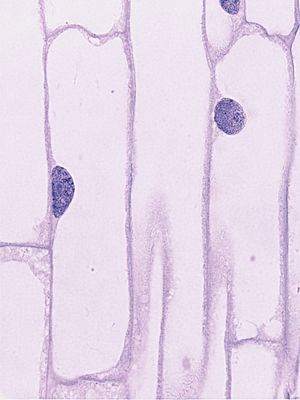Protoplasm facts for kids

Protoplasm is an older word. It used to mean the living material that makes up a cell. Today, scientists do not use this word much. They prefer to talk about the cytoplasm and the cell nucleus.
Contents
What is Protoplasm?
Protoplasm is the entire living content of a cell. It includes the cytoplasm, the nucleus, and all the tiny parts inside them. These parts are called organelles.
Protoplasm in Plant Cells
In plant cells, the protoplasm is surrounded by a strong cell wall. This wall gives the plant cell its shape and support. Inside the cell wall, there is a cell membrane.
Protoplasm in Animal Cells
In animal cells, there is no cell wall. The entire cell is made of protoplasm. It is surrounded only by a flexible cell membrane. This membrane controls what goes in and out of the cell.
What is Protoplasm Made Of?
Protoplasm is mostly water, about 75% to 80%. But it is much more than just water. It is filled with many different organelles. Each organelle has a special job to do. For example, the endoplasmic reticulum is a large network of membranes. It helps make and transport proteins and fats.
Why the Word "Protoplasm" is Less Used Now
The word "protoplasm" was first used in 1846. A scientist named Hugo von Mohl used it to describe the living stuff in plant cells. He knew it was inside the cell wall, but he did not know much about its details.
Later, new tools like the electron microscope were invented. Scientists could then see inside cells much better. They discovered that a living cell is far more complex than von Mohl knew. They found many different organelles with specific roles. Because of these discoveries, scientists started using more specific terms. They now talk about the cytoplasm and the cell nucleus instead of the general term "protoplasm."
See also
 In Spanish: Protoplasma para niños
In Spanish: Protoplasma para niños

